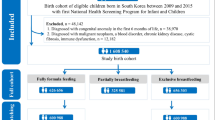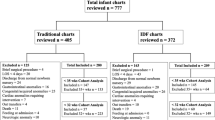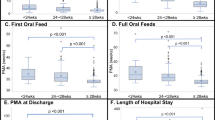Abstract
Objective:
To assess the impact of early infant feeding practices on low birth weight- (LBW) specific neonatal mortality in rural Ghana.
Study Design:
A total of 11 787-breastfed babies were born between July 2003 and June 2004 and survived to day 2. Overall, 3411 (30.3%) infants had weight recorded within 48 h. Two hundred and ninety-six (8.7%) infants were <2.5 kg and 15 died in the neonatal period. Associations were examined using multivariate logistic regression.
Result:
Initiation of breastfeeding after day 1 was associated with a threefold increase in mortality risk (adjusted odds ratio (adjOR) 3.23, 95% confidence interval (95% CI) (1.07–9.82)) in infants aged 2 to 28 days. Prelacteal feeding was associated with a threefold significantly increased mortality risk (adjOR 3.12, 95% CI (1.19–8.22)) in infants aged 2 to 28 days but there was no statistically significant increase in risk associated with predominant breastfeeding (adjOR 1.91, 95% CI (0.60–6.09)). There were no modifications of these effects by birth weight. The sample size was insufficient to allow assessment of the impact of partial breastfeeding.
Conclusion:
Improving early infant feeding practices is an effective, feasible, low-cost intervention that could reduce early infant mortality in LBW infants in developing countries. These findings are especially relevant for sub-Saharan Africa where many LBW infants are born at home, never taken to a health facility and mortality rates are unacceptably high.
This is a preview of subscription content, access via your institution
Access options
Subscribe to this journal
Receive 12 print issues and online access
$259.00 per year
only $21.58 per issue
Buy this article
- Purchase on Springer Link
- Instant access to full article PDF
Prices may be subject to local taxes which are calculated during checkout

Similar content being viewed by others
References
McCormick MC . The contribution of low birth weight to infant mortality and childhood morbidity. N Engl J Med 1985; 312 (2): 82–90.
Ashworth A . Effects of intrauterine growth retardation on mortality and morbidity in infants and young children. Eur J Clin Nutr 1998; 52 (Suppl 1): S34–S41; discussion S41–S42.
Lucas A, Cole TJ . Breast milk and neonatal necrotising enterocolitis. Lancet 1990; 336 (8730): 1519–1523.
Schanler RJ, Schulman RJ, Lau C . Feeding strategies for premature infants: beneficial outcomes of feeding fortified human milk vs preterm formula. Pediatrics 1999; 103 (6 Part 1): 1150–1157.
Avery GB, Fletcher MA . Neonatology: Pathophysiology and Management of the Newborn. Lippincott, Williams & Wilkins: London, 2005.
Save The Children. State of the World's Newborns. Saving Newborn Lives. Washingtom DC, 2001; 1–49.
Macro International. Demographic and Health Surveys (DHS) www.measuredhs.com(accessed June 10, 2006).
Edmond KM, Zandoh C, Quigley MA, Amenga-Etego S, Owusu-Agyei S, Kirkwood BR . Delayed breastfeeding initiation increases risk of neonatal mortality. Pediatrics 2006; 117 (3): 380–386.
Ghana Statistical Service (GSS), Noguchi Memorial Institute for Medical Research (NMIMR), and ORC Macro. 2004. Ghana Demographic and Health Survey 2003. GSS, NMIMR, and ORC Macro: Calverton, Maryland.
World Health Organization: Division of Child Health and Development. Indicators for Assessing Breastfeeding Practices. World Health Organization: Geneva, 1991.
Daga SR, Daga AS . Reduction in neonatal mortality with simple interventions. J Trop Pediatr 1989; 35 (4): 191–196.
Pratindhi AK, Shroti AN, Shah U, Bodhani ND . Domicillary care of low birth weight neonates. Indian J Pediatr 1986; 53 (1): 87–92.
Bang AT, Baitule SB, Reddy HM, Deshmukh MD, Bang RA . Low birth weight and preterm neonates: can they be managed at home by mother and a trained village health worker? J Perinatol 2005; 25 (Suppl 1): S72–S81.
Conde-Agudelo A, Diaz-Rossello JL, Belizan JM . Kangaroo mother care to reduce morbidity and mortality in low birthweight infants. Cochrane Review. Update Software: Oxford, UK, 2003.
Habicht JP, DaVanzo J, Butz WP . Does breastfeeding really save lives, or are the potential benefits due to biases? Am J Epidemiol 1986; 123: 279–290.
Bauchner H, Leventhal JM, Shapiro ED . Studies of breast feeding and infection: how good is the evidence? JAMA 1986; 256: 887–892.
Gunnlaugsson G, Da Silva M, Smedman L . Determinants of delayed initiation of breast feeding: a community and hospital study from Guinea Bissau. Int J Epidemiol 1992; 21: 935–940.
Victora CG, Barros FC, Vaughan JP, Teixeira AM . Birthweight and infant mortality: a longitudinal study of 5914 Brazilian children. Int J Epidemiol 1987; 16 (2): 239–245.
Barros FC, Huttly SR, Victora CG, Kirkwood BR, Vaughan JP . Comparison of the causes and consequences of prematurity and intrauterine growth retardation: a longitudinal study in southern Brazil. Pediatrics 1992; 90 (2 Part 1): 238–244.
Barros FC, Victora CG, Vaughan JP, Smith PG . Birth weight and duration of breast-feeding: are the beneficial effects of human milk being overestimated? Pediatrics 1986; 78 (4): 656–661.
Sauls HS . Potential effect of demographic and other variables in studies comparing morbidity of breast-fed and bottle-fed infants. Pediatrics 1979; 64 (4): 523–527.
Edmond KM, Kirkwood BR, Amenga-Etego S, Owusu-Agyei S, Hurt LS . Effect of early infant feeding practices on infection-specific neonatal mortality: an investigation of the causal links with observational data from rural Ghana. Am J Clin Nutr 2007; 86 (4): 1126–1131.
Goldman AS . The immune system of human milk: antimicrobial, antiinflammatory and immunomodulating properties. Pediatr Infect Dis J 1993; 12 (8): 664–671.
Carver J, Barness L . Trophic factors for the gastrointestinal tract. Clin Perinatol 1996; 23: 265–285.
Anderson GC, Moore E, Hepworth J, Bergman N . Early skin-to-skin contact for mothers and their healthy newborn infants. Cochrane Review. Update Software: Oxford, UK, 2003.
De L Costello AM, Pal DK, Manandhar DS, Rajbhandari S, Land JM, Patel N . Neonatal hypoglycaemia in Nepal 2: availability of alternative fuels. Arch Dis Child Fetal Neonatal Ed 2000; 82 (1): F52–F58.
Darmstadt GL, Bhutta ZA, Cousens S, Adam T, Walker N, de Bernis L . Evidence-based, cost-effective interventions: how many newborn babies can we save? Lancet 2005; 365 (9463): 977–988.
Acknowledgements
This study was supported by the UK Department for International Development (DFID), the US Agency for International Development (USAID), Ghana Health Service and the London School of Hygiene and Tropical Medicine. We thank the mothers who participated in this study for their cooperation and patience, the field and computer centre staff at Kintampo Health Research Centre (KHRC) for their dedication and attention to detail and the ObaapaVitA trial steering committee for their support and encouragement. KHRC is a member of the Indepth network. Sources of support: This work was funded by the United Kingdom Department for International Development (DFID) and the United States Agency for International Development (USAID).
Author information
Authors and Affiliations
Corresponding author
Rights and permissions
About this article
Cite this article
Edmond, K., Kirkwood, B., Tawiah, C. et al. Impact of early infant feeding practices on mortality in low birth weight infants from rural Ghana. J Perinatol 28, 438–444 (2008). https://doi.org/10.1038/jp.2008.19
Received:
Revised:
Accepted:
Published:
Issue Date:
DOI: https://doi.org/10.1038/jp.2008.19
Keywords
This article is cited by
-
Impact of breastfeeding on mortality in sub-Saharan Africa: a systematic review, meta-analysis, and cost-evaluation
European Journal of Pediatrics (2020)
-
A qualitative exploration of the sociocultural determinants of exclusive breastfeeding practices among rural mothers, North West Nigeria
International Breastfeeding Journal (2019)
-
Prelacteal feeding and associated factors among newborns in rural Sidama, south Ethiopia: a community based cross-sectional survey
International Breastfeeding Journal (2018)
-
Factors associated with delayed initiation of breastfeeding: a cross-sectional study in South Sudan
International Breastfeeding Journal (2018)
-
“When you give birth you will not be without your mother” A mixed methods study of advice on breastfeeding for first-time mothers in rural coastal Kenya
International Breastfeeding Journal (2016)



